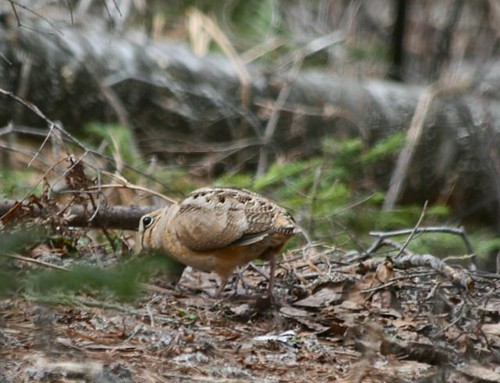Timberdoodle Time
Woodcocks are one of the little miracles of early spring. While they were pretty much done performing their twirling display flights back home, on the U.P. they were just getting going. On my last day birding, this little gentleman careened across the road in front of my car, landing with a soft plump in the leaf litter beneath some spruces. I pulled over and very quietly trained my lens on him.
.

When they're aware of being watched, woodcocks do a little deep-knee bend that is utterly charming. They bob and weave, perhaps making themselves even harder to detect as they putter along. This could also help camouflage them from the prey they're hunting, making them look like part of the moving foliage overhead. But then, do earthworms have eyes? So much for that theory...I suppose some of the woodcock's prey has eyes.
I don't think anyone really knows why woodcocks do constant plie's (I have no idea how to spell that, and am too lazy to begin to know how to look it up) while they work. While I was at the Cornell Lab of Ornithology, a woodcock dropped into a moist section of Sapsucker Woods and entertained hundreds of people over the course of the week (I missed it, unfortunately). The main topic of discussion among the ornithologists was the bob and weave behavior of the bird. It's impossible to know whether the bird would do this if we weren't looking at it; it's one of those "if a tree fell in the forest with no one to hear it" questions. ** You're looking at it; it's bobbing; would it bob if you weren't looking at it? I tend to err on the side of giving the bird credit for being supremely aware that it's being watched, and for altering its behavior while being observed, no matter how calm and nonchalant it seems.
**A permutation of that concept that I like is, "If a man made a statement in the middle of a forest without a woman to hear him, would he still be wrong?"
I don't know why I said that. This is a bird post.

As I watched, the woodcock foraged. Note the very high placement of its eyes. The woodcock has the largest field of vision of any North American bird, almost 360 degrees without turning its head, with very narrow blind spots directly in front of its forehead and at the back of its head. Imagine being able to see a panorama all the way around you. That's got to come in handy when you've got your bill stuck deep in the mud, feeling around for earthworms. It's also probably great for keeping watch on your rivals as you all display together in a meadow.
Its bill is also very cool. The woodcock can insert the bill up to its hilt in the earth, and, without opening it, grab a worm. How? It has a tendon running along the upper ridge (the culmen) of the upper bill (maxilla) that, when contracted, pulls open just the tip of the upper bill. If you're ever lucky enough to have a road-killed woodcock in the hand, try playing with its bill. I have. It's like a miniature can grabber. Obviously, it works. Slurrp!

I often wonder what woodcocks ate before the colonists brought their earthworms to the New World. And I'm still wondering about that guy, standing out in the middle of the forest.
This brings to a wormy end the posts about the Upper Peninsula. I truly hope to get back sometime when I don't have to rush right off somewhere else. It is a magical place, and it makes me want to get in my canoe and paddle off to see what I can see. Still can't believe I saw a wolf there.
Labels: American woodcock, woodcock bill, woodcock eyes





